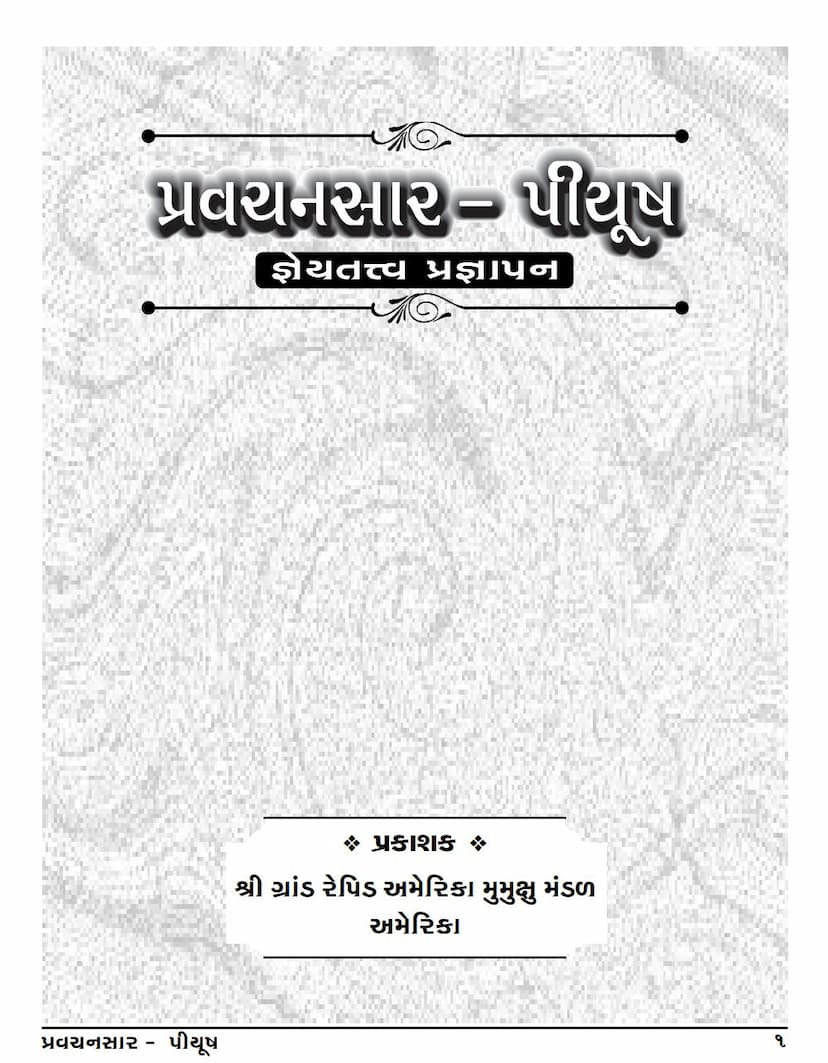Pravachansara Piyush Part 2
Added to library: September 2, 2025
Loading image...

Summary
This document is the second part of the "Pravachansara Piyush" (nectar of Pravachansara), compiled by Himmatlal Jethalal Shah. It focuses on the "Sheya Tattva Prajnapana" (exposition of knowable truths) section of the Jain scripture, authored by Kundkundacharya and commented upon by Amritchandracharya.
Key Themes and Content:
- Publisher: Grand Rapid America Mumukshu Mandal America.
- Foreword: The foreword expresses deep gratitude to Kundkundacharya, Amritchandracharya, Kananguru Dev, Pujya Behanshri, and Panditji for their influence and efforts in spreading the Jain teachings, especially in the current difficult era. It highlights the importance of understanding fundamental Jain principles for those seeking spiritual liberation. The text acknowledges a spiritual awakening spurred by a five-month intensive study program, receiving guidance from scholars and blessings from revered figures.
- Focus on "Sheya Tattva Prajnapana": This section of the Pravachansara is considered a pillar of Jainism. It delves into the fundamental principles of Jain philosophy with profound depth and scientific rigor.
- Key Concepts Explained:
- Dravya (Substance): The text elaborates on the nature of substance as a combination of production (utpad), decay (vyay), and persistence (dhrauvya) without losing its essence. It discusses the internal structure of substance in terms of substance-attribute-mode (dravya-guna-paryaya) and the principles of production-decay-persistence.
- Sadvada (Anekanta): The importance of the anekanta (non-one-sided) nature of reality and the corresponding syadvada (conditional predication) style of expression are emphasized.
- Naya and Pramana: The text explains the nature of different logical standpoints (naya) and valid knowledge (pramana).
- Self-Other Discrimination (Bhed Vijnana): The core of this section is the explanation of bhed vijnana (discrimination between self and non-self), which is presented as the tool to sever the root of suffering.
- Substance vs. Attributes and Modes: It elucidates the fundamental principle that every reality is a collection of substance, attributes, and modes, and the interplay of production-decay-persistence.
- Nature of Reality: The text emphasizes that each reality is characterized by its oneness with itself and distinctness from others. Every substance is characterized by its eternal nature, which exists through production-decay-persistence, and its attributes and modes.
- The Six Substances: The intrinsic structure of reality is explained in detail, highlighting the commonalities and differences among the six substances (soul, matter, space, time, dharma, adharma).
- The Principle of Non-Contradiction: The text explores how seemingly contradictory qualities like unity and multiplicity, or eternality and non-eternality, can coexist within a single reality.
- The Omniscient Viewpoint: The author highlights that the description of substance in Pravachansara is presented with profound insight, akin to a scientist's perspective, making the understanding of general substance and specific substances accessible.
- Living Beings and Non-Living Matter: The text explains the distinction between living beings (soul) and non-living matter, including the soul's non-involvement in the actions of the body, mind, and speech. It also details the concept of karma and its bondage.
- Bhed Vijnana in Practice: The importance of applying this knowledge to distinguish the self from the non-self is stressed for achieving liberation.
- Structure: The document contains a detailed table of contents listing the verses (gathas) covered, from 93 to 199, indicating the comprehensive nature of this volume.
- Philosophical Depth: The text emphasizes that understanding Jain philosophy leads to the realization that "Jainism is the perception of reality." It praises Kundkundacharya and Amritchandracharya for their profound explanations that bridge the gap left by the absence of Tirthankaras and Shrutkevalis.
- Key Concepts Explained:
- Purpose: The publication aims to benefit sincere seekers of Jain truth by presenting these profound principles in an accessible manner, facilitating a systematic study.
- Author's Acknowledgment: The compiler expresses gratitude for the opportunity to participate in the publication of "Jain Tattvadarshan" (parts 1-5), which was well-received. The foreword also praises the method of scripture study centered around the pure soul, as explained by Pujya Gurudevshri.
- Emphasis on Pravachansara: It is mentioned that while studying Pravachansara might seem difficult, Himmatbhai Shah emphasized its importance as a starting point for understanding other scriptures.
In essence, this part of Pravachansara Piyush serves as an in-depth exploration of the fundamental nature of reality according to Jainism, focusing on substance, its attributes, modes, and the crucial concept of self-other discrimination for spiritual progress. It acts as a guide for those seeking to systematically understand and practice the core tenets of Jain philosophy.